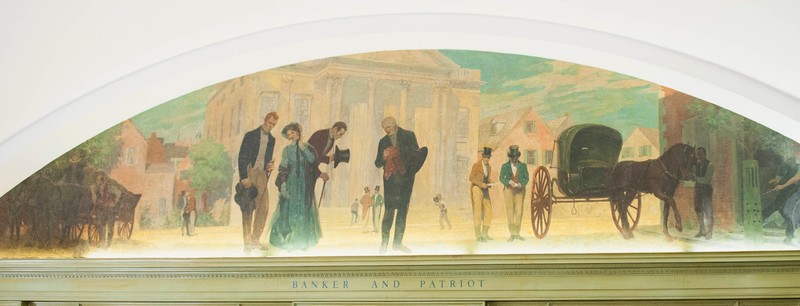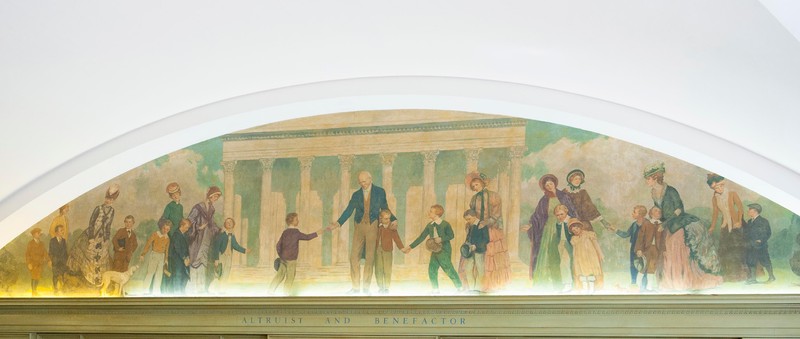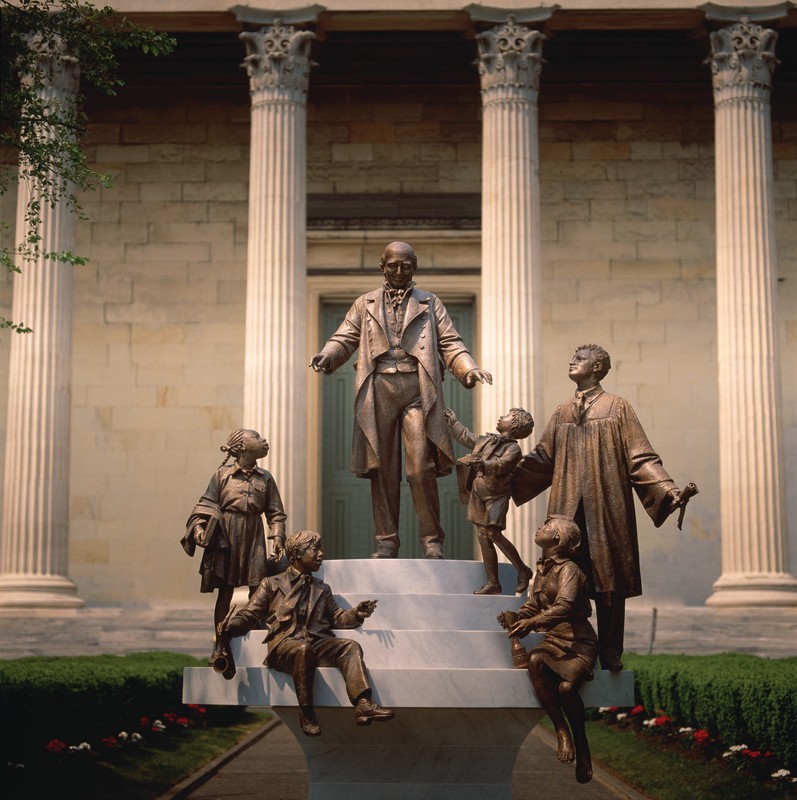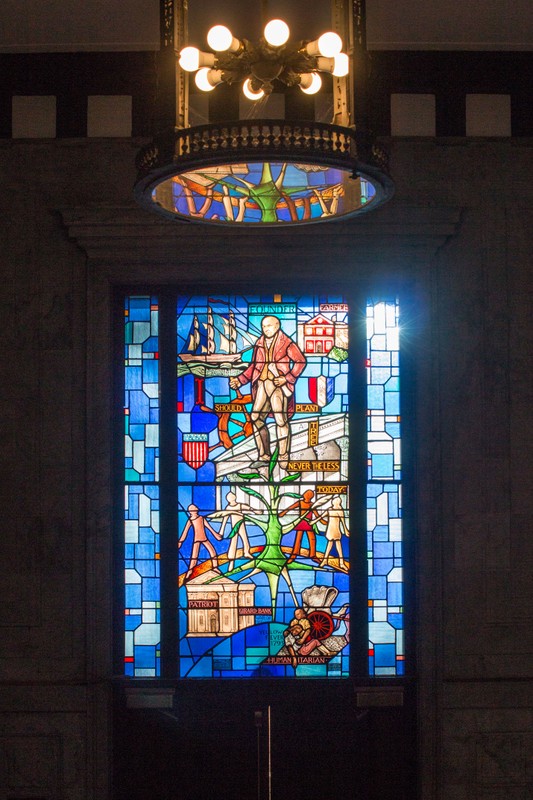The Murals: A Life in Four Frames
Introduction
Text-to-speech Audio
These four murals, painted by American artist George Gibbs and installed in Founder’s Hall in 1929, depict significant aspects of Stephen Girard’s life and his contributions to Philadelphia. While they do not portray any specific moment in Girard’s life, each mural depicts a fictional scene, highlighting a specific cause or occupation that he was dedicated to. They are arranged roughly chronologically, beginning with the mural titled “Mariner and Merchant” and continuing counterclockwise.
Images
Mariner and Merchant

Banker and Patriot

Citizen and Humanitarian

Altruist and Benefactor

Spirit of Girard statue in front of Founder's Hall

Stained glass window in the high school building, inspired by the murals

Backstory and Context
Text-to-speech Audio
These four murals were added to the room in 1929. They were painted by George Gibbs, an artist and author who worked extensively for the Curtis Publishing Company, including the Saturday Evening Post and Ladies Home Journal. His signature can be seen at the lower right of the "Mariner & Merchant" image. The murals are not painted directly on the walls, but on canvas which is attached to backing boards inserted in the semi-circular spaces.
The “Mariner and Merchant” mural portrays Girard conducting business at the Delaware River waterfront. Girard became a mariner at the young age of 13, a captain at 23 and first arrived in Philadelphia in 1776. His arrival here was unintentional. He was captaining a ship headed for New York from the Caribbean, but due to stormy weather and a lack of clean water on the boat, he needed to put into Philadelphia. Hearing of the blockade of the New York harbor, he decided to remain in the city. He liked what he found in this prosperous trading center and Philadelphia would be his home for the rest of his life. Throughout the next few years, he accumulated his first great fortune as a merchant in international trade, sending ships to North and South America, Europe, Africa, and Asia.
The second mural, “Banker and Patriot”, shows Girard standing in front of the Bank of Stephen Girard, which he established after buying the property of the defunct First Bank of the United States in 1811. Girard and his bank were instrumental in funding the War of 1812, taking on half of a $16 million war loan to the U.S. Government.
The third mural, “Citizen and Humanitarian”, depicts Girard running a hospital during the 1793 Yellow Fever outbreak in Philadelphia. The epidemic claimed the lives of over 5,000 out of the 31,000 people of the city. Over 17,000 Philadelphia residents fled the city during the outbreak, including President George Washington and other members of the government, as well as ministers, newspaper editors, and most wealthy individuals who could afford to leave. Girard instead decided to remain in the city to help those afflicted by the disease. He became administrator of the Bush Hill hospital in the midst of the epidemic, and employed doctors John Deveze and Benjamin Duffield to introduce French medical practices to combat the disease. The mural depicts a sick man being brought into the hospital; the Black coachman helping carry him reflects both the large number of African Americans in this trade and also the disproportionate role of the Black community in caring for the fever sufferers (partly because it was mistakenly believed that they were immune to the fever). The smoking pots in front of the hospital reflect the idea that the fever might be caused by bad air (miasma) and so burning strong-smelling material like gunpowder could be protective.
The final mural, “Altruist and Benefactor” shows Girard standing in front of Girard College. Girard never saw the school in the flesh; it opened in 1848, seventeen years after his death. The painting imagines a proud Girard, as he looks on to the students that will be educated through his $6 million gift. Today, around 90% of the school’s funding continues to come from the endowment Girard left behind. The mural shows the original school population of "poor white male orphans;" orphan was defined as "fatherless" and the boys' mothers can be seen at the edges of the mural. Girard was desegregated in 1968 and went co-ed in 1984. Today the school serves of 98% students of color.
The imagery in these murals inspired and influenced later depictions of Girard on campus, including a stained glass window in the High School showing Girard's achievements and legacy and the Spirit of Girard statue in front of Founder's Hall, depicting Stephen Girard with students.
Sources
Wilson, George. Stephen Girard: The Life and Times of America's First Tycoon. PA. Signpost Books, 1995.
Girard College Historical Collection
Girard College Historical Collection
Girard College Historical Collection
Girard College Historical Collection
Girard College Historical Collection
Girard College Historical Collection
